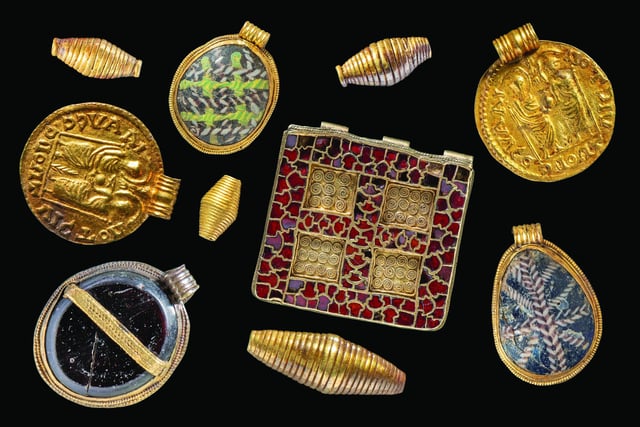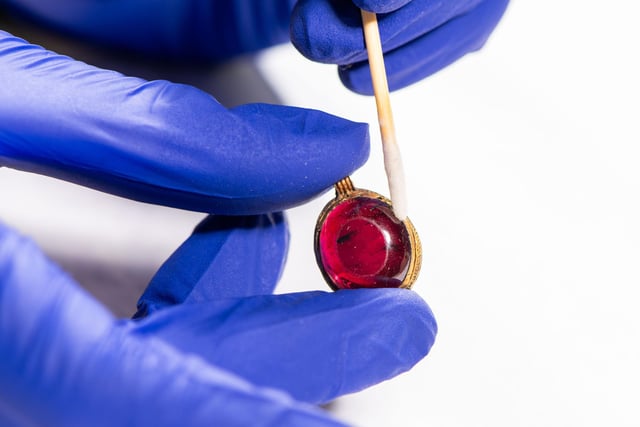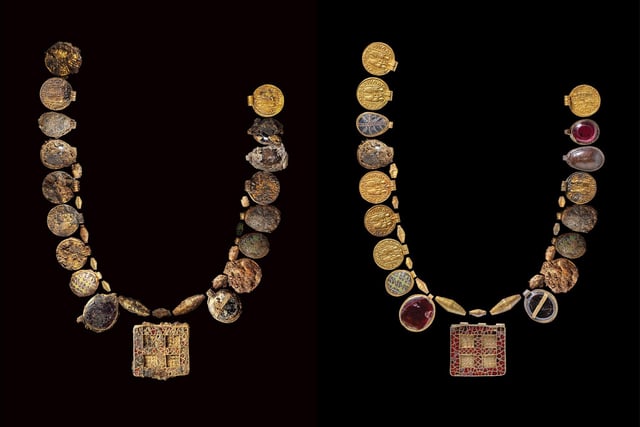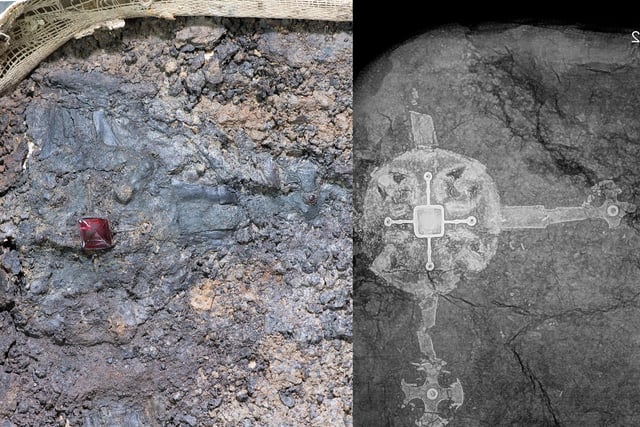Archaeologists have unveiled extraordinary details of a 1,300-year-old burial found in a quiet village on the edge of Northampton.
The burial, found in Harpole and dubbed the Harpole Burial, is believed to be one of the most significant early-medieval female burials ever found in Britain.
Discovered in 2022 during archaeological works preceding the Vistry Group’s Western Gate housing development, the site has since captivated experts at Museum of London Archaeology (MOLA) with its remarkable artefacts.
Careful cleaning has exposed an array of treasures, including a gold and gemstone necklace comprising 30 pendants and beads. The meticulous restoration has unveiled intricate gold work, rich colours of semi-precious stones, and multi-coloured glass that were concealed by soil, say MOLA.
A large silver and gold cross, backed with wood, has also been unearthed after months of painstaking work. The cross features a smaller gold cross adorned with a large garnet and four smaller garnets, along with smaller circular crosses made of silver with garnet and gold centres at each arm. This unique configuration suggests the individual may have held a special position within the Christian community, according to MOLA.
Micro-excavations of the cross, conducted under controlled lab conditions, have revealed that it is mostly made of extremely thin sheets of silver attached to wood. Conservators at MOLA say they aim to identify the type of wood used and gain a deeper understanding of the cross's construction.
MOLA goes on to say that osteological observations indicate that the burial likely belonged to a young adult. Additional human remains, including fragments of the skeleton, have been discovered. MOLA osteologists have identified the upper part of a femur, part of the pelvic bone, vertebrae, and part of a hand and wrist. These findings lay beneath a crushed copper dish, which has aided in preserving the 1,300-year-old organic material.
While early analysis suggests the skeleton is likely that of a woman, further tests are underway to confirm biological sex and gather details about her origins, say MOLA. The ongoing research aims to not only unravel the story of the individual buried at Harpole but also shed light on funerary rituals of the time, say archaeologists.
MOLA Conservator, Riva Boutylkova said: “Our work on the Harpole Burial has really demonstrated the value of block lifting and micro-excavating these types of features. We have been able to find and record details that may have been lost outside of the controlled conditions of the lab. This unlocks a world of possibilities for future research and analysis, which will give us a much richer understanding of this extraordinary find.”
RPS Archaeology Consultant Simon Mortimer said: “Seeing the central gold and garnet clasp cleaned up is breath-taking. We always knew that it stood alongside Sutton Hoo and the Staffordshire Hoard – but this confirms it. The key is now to reassemble all of the evidence that was buried on that day with this lady – to understand the full significance of who she was, where she was from and how she came to be here and why. Those answers will rewrite our understanding of early Medieval Northamptonshire.”
Dan Oliver, technical director at Vistry West Midlands, said: “It has been fascinating to learn more about the history of our Western Gate development. While our role is to create new communities, we are pleased that this archaeological project has uncovered so much about past civilisations. It is a privilege to have been involved in such an important project and we look forward to learning more as MOLA’s research continues.”


2. Harpole Treasure
Cleaning garnet and gold pendant from Harpole Burial necklace Photo: MOLA


